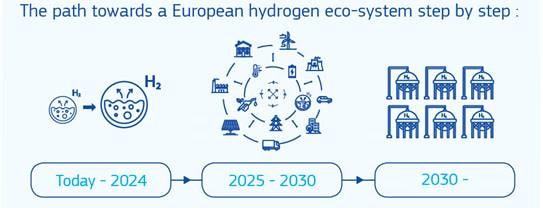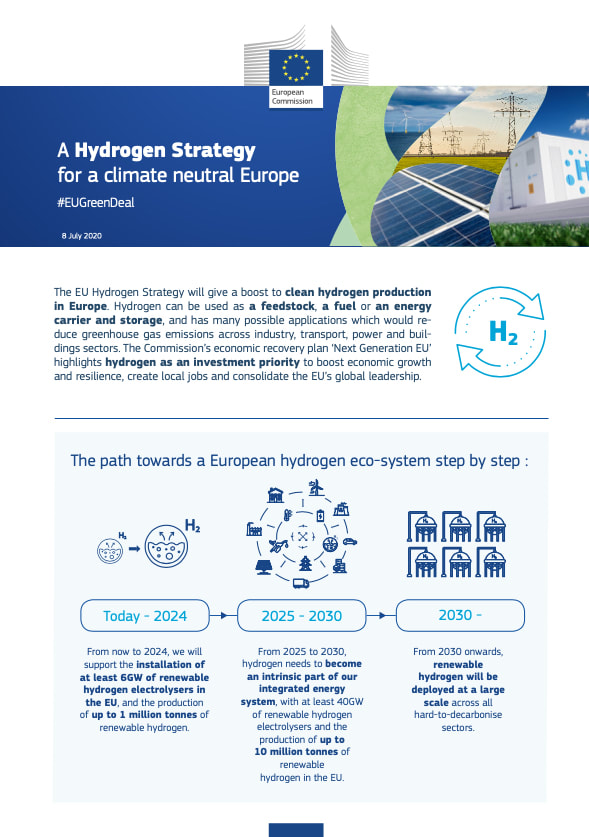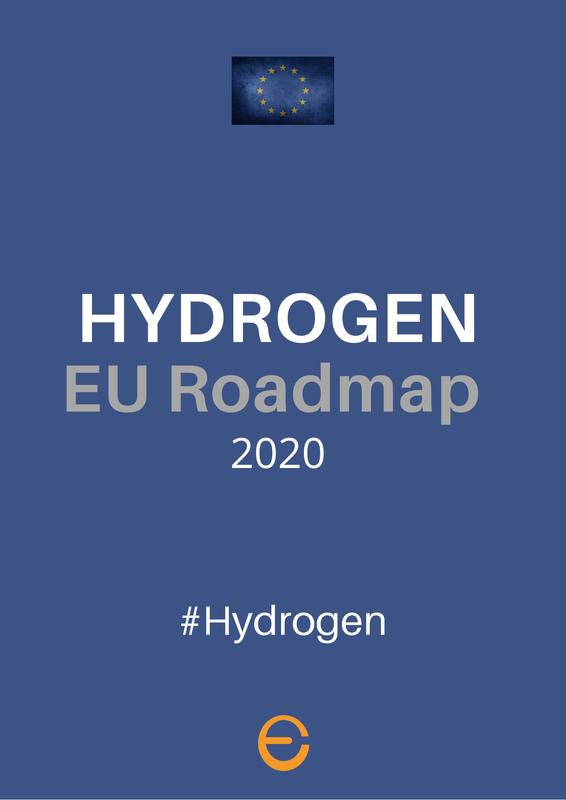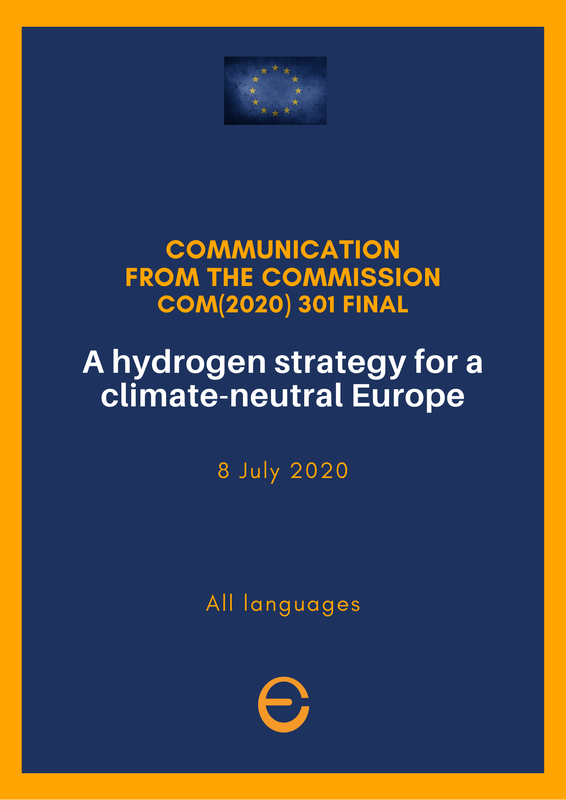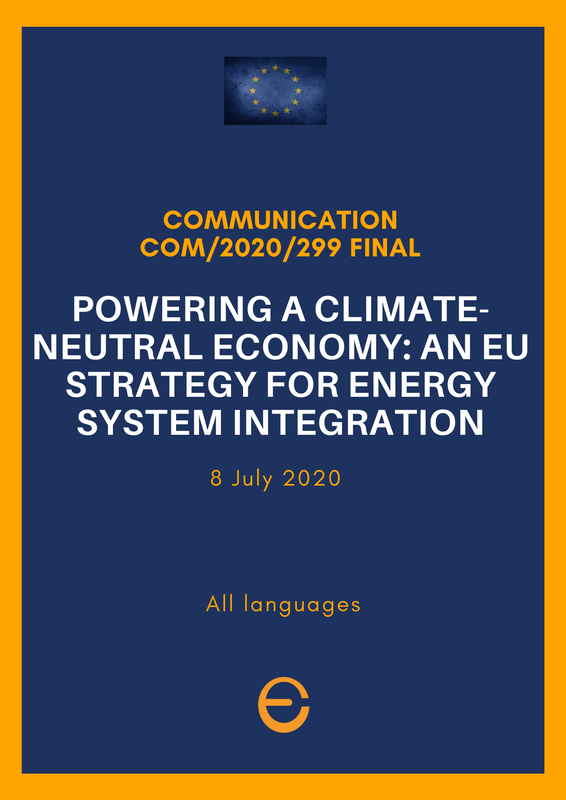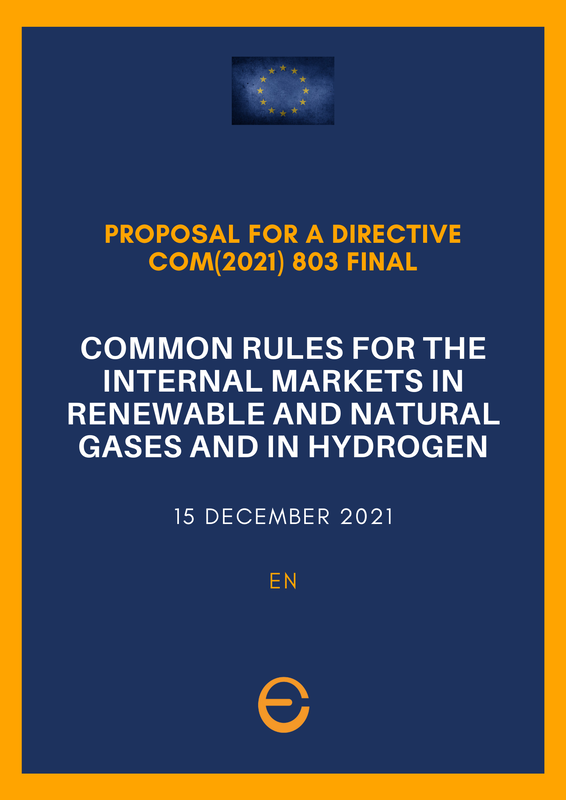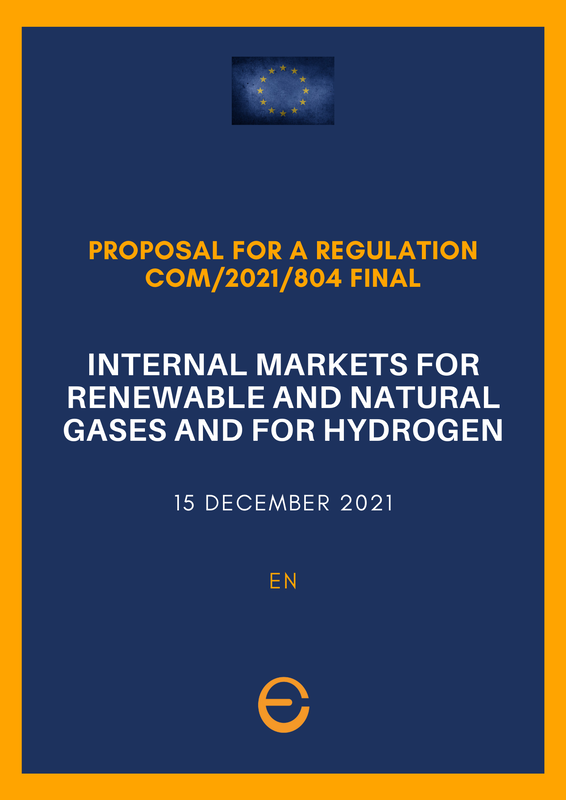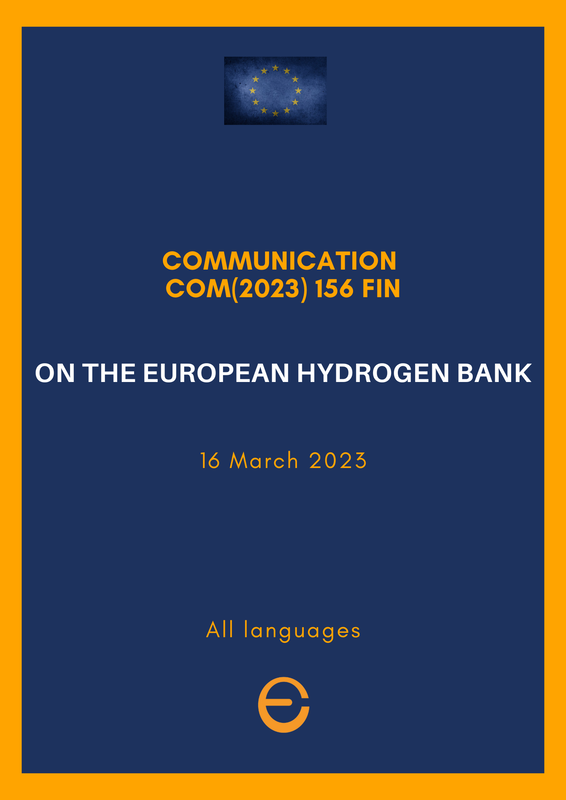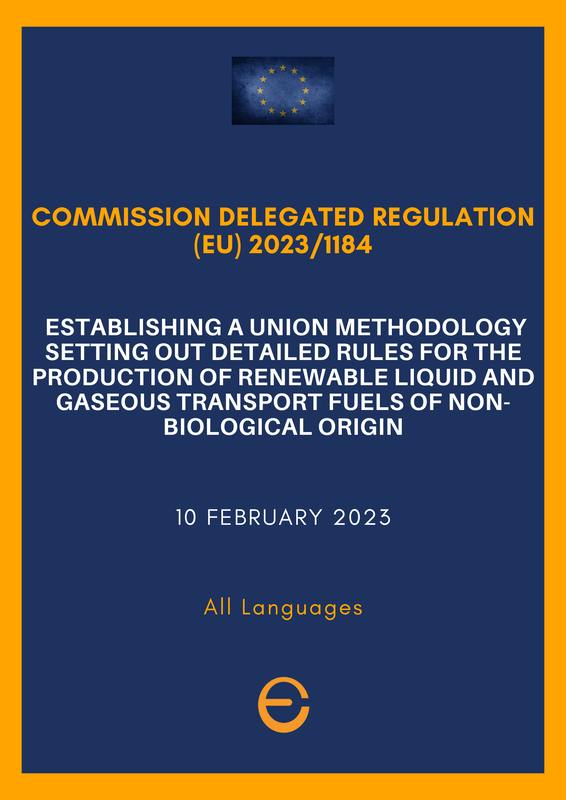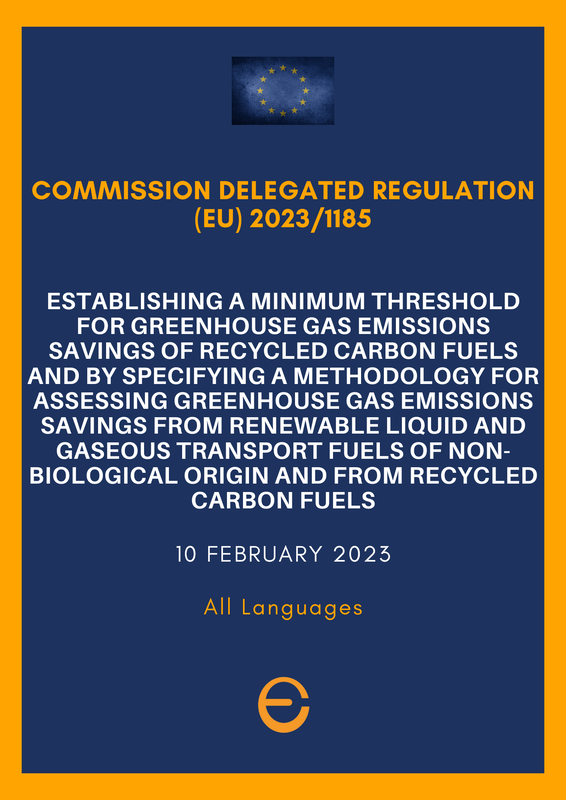|
Brussels, |
|
Hydrogen
A way to decarbonise
The European decarbonisation objectives, accelerated by the desire to disengage from imports of fossil fuels, in particular from Russia, have assigned an important strategic place to hydrogen. But today hydrogen is mainly used in the chemical industry to produce plastics and fertilizers, is essentially produced from natural gas and contributes only 2% to the primary energy supply. The EU has therefore drawn up a strategic plan to achieve the goal of producing hydrogen at least up to 14% of energy needs.
The goal is not only to produce more hydrogen, but also to produce it from renewable, i.e. non-polluting, sources.
Today almost all of it is produced from natural gas, therefore with a large production of CO2 released into the environment. But it can also be produced through electrolysis and now that the technology is more promising, the EU wants to encourage the use of electricity from renewable sources.
The EU believes that so-called renewable hydrogen, also called green hydrogen, should play a key role in decarbonising sectors where other alternatives may not be feasible or may be more expensive: heavy and long-haul transport and energy-intensive industrial processes.
For this reason, the European Commission adopted a series of legislative proposals in December 2021 to decarbonise the EU gas market, one way to switch to hydrogen.
On 16 March 2023, the European Commission has set out new plans to stimulate and support investment in sustainable hydrogen production through a European Hydrogen Bank (EHB). Hydrogen can make a major contribution to the EU’s ambitions to end imports of Russian fossil fuels in the next few years and to achieve climate-neutrality by 2050. This initiative is aimed at accelerating investment and bridging the investment gap for the EU to reach its ambitious REPowerEU targets of producing domestically 10 million tonnes (mt) of renewable hydrogen by 2030, coupled with 10 mt of imports.
EU & Hydrogen
To achieve all these objectives, the EU acts on several fronts:
- EU strategy
- collaboration between industries
- stimulation of research
2020: EU launches its Hydrogen Strategy
|
Creation of a European hydrogen ecosystem
The EU strategy for energy system integration outlines a vision to create a smarter, more integrated and optimised energy system, in which all sectors can fully contribute to decarbonisation. Hydrogen is considered to be an important element of that strategy and its key role and its wider scope warrant a specific approach. In December 2019, the Commission presented the European Green Deal as the new European Growth Strategy setting out a clear agenda to make Europe by 2050 the first climate neutral continent in the world and to enhance the EU's natural capital. In 2020, the Commission published a Roadmap on the fortcoming initiatives on Hydrogen and on 8 July 2020 a Strategy on hydrogen in Europe (see on the side), in parallel with the strategy on energy system integration (see below). It will bring together different strands of action, from research and innovation over production and infrastructure to the international dimension The role of hydrogen
The new hydrogen strategy explores the potential of clean hydrogen to help the process of decarbonising the EU economy in a cost-effective way, in line with the 2050 climate-neutrality goal, set out in the European Green Deal. It should also contribute to the recovery from the economic effects of COVID-19. The strategy launches actions to support the production and use of clean hydrogen, with a particular focus on the integration of renewable hydrogen. More details in the factsheet “A Hydrogen Strategy for a climate neutral Europe”. Before the strategy was adopted, as mentioned before, goals were presented in a EU Hydrogen Strategy Roadmap, launched on 26 May and open for feedback from stakeholders and the public until 8 June 2020. To support the hydrogen strategy, the Commission conducted a study on hydrogen generation in Europe. The study collects evidence based on the latest publicly available data for identifying investment opportunities in the hydrogen value chain over the period from 2020 to 2050, and the associated benefits in terms of jobs. Of course, the resistance of industrial and production systems to the abandonment of the fuels they use today for hydrogen is and will be high and therefore the EU's goals of achieving climate neutrality could be undermined by large energy consumers.
For this reason, the EU seeks to create increasingly favorable conditions for conversion to hydrogen, thanks also to the fact that transformed hydrogen provides high-quality heat that can be used in transport as a fuel, in industries as a material and in agriculture for fertilizers. For example, the revision of the TEN-E envisages giving priority to electricity interconnection networks. Not only that, the EU is also studying to create a hydrogen distribution network, so that it can reach future consumers. 2021: New legislative proposalsOn 15 December 2021, the European Commission adopted a set of legislative proposals to decarbonise the EU gas market by facilitating the uptake of renewable and low carbon gases, including hydrogen, and to ensure energy security for all citizens in Europe.
The Commission is also following up on the EU Methane Strategy and its international commitments with proposals to reduce methane emissions in the energy sector in Europe and in our global supply chain. The European Union want to decarbonise the energy it consumes to reduce greenhouse gas emissions by at least 55% by 2030 and become climate-neutral by 2050, The Commission has set up an informal Group of experts, composed of representatives from the ministries in charge of energy policy in EU Member States, called the Hydrogen Energy Network (HyENet). This expert group aims to support national authorities in charge of energy policy to develop on the opportunities offered by hydrogen as an energy carrier. HyENet will act as an informal platform of exchange for information, sharing of good practices, experiences and latest developments, as well as joint work on specific issues. Here the meeting proceedings. 2022: The EU set-up Hydrogen acceleratorWith the publication of the REPowerEU plan in May 2022, the European Commission completes the implementation of the European hydrogen strategy while further increasing the European ambitions for renewable hydrogen as an important energy carrier to move away from Russia fossil fuel imports.
In a Staff Working Document accompanying the REPowerEU plan, the Commission outlines a ‘hydrogen accelerator’ concept to scale up the deployment of renewable hydrogen, which will contribute to accelerating the EU’s energy transition and decarbonising the EU’s energy system. The REPowerEU plan’s ambition is to produce 10 million tonnes of renewable hydrogen in the EU by 2030 – increased from the 5.6 million tonnes foreseen within the revised Renewable Energy Directive, published in July 2021 –, and to import 10 million tonnes of renewable hydrogen from third countries. 2023: EU plans Hydrogen infrastructuresThis is still a proposal to accelerate the uptake of renewable hydrogen, ammonia and other derivatives in hard-to-decarbonise sectors, such as transport, and in energy-intensive industrial processes. Scaling up the development of hydrogen infrastructure and supporting hydrogen investments are also identified as key areas to support hydrogen uptake in the EU.
On 13 February 2023, the Commission has proposed detailed rules to define what constitutes renewable hydrogen in the EU, with the adoption of 2 Delegated Acts required under the Renewable Energy Directive. These Acts are part of a broad EU regulatory framework for hydrogen which includes energy infrastructure investments and state aid rules, and legislative targets for renewable hydrogen for the industry and transport sectors. They will ensure that all renewable fuels of non-biological origin (also known as RFNBOs) are produced from renewable electricity. The two Acts are inter-related and both necessary for the fuels to be counted towards Member States' renewable energy target. They will provide regulatory certainty to investors as the EU aims to reach 10 million tonnes of domestic renewable hydrogen production and 10 million tonnes of imported renewable hydrogen in line with the REPowerEU Plan. |
2023: EU creates the Hydrogen Bank
|
Within the hydrogen accelerator measures, the Commission proposes to establish through a European Hydrogen Bank (EHB) a global European hydrogen facility to create investment security and business opportunities for European and global renewable hydrogen production.
To this end, green hydrogen partnerships will also facilitate the promotion of the import of renewable hydrogen from third countries and contribute to incentivising decarbonisation. Together, the global European hydrogen facility and the green hydrogen partnerships aim at delivering a framework to ensure that partnerships established by the EU countries and the industry provide a level-playing field between EU production and third-country imports. As the first final investment decisions were only taken last year and the vast majority of projects are still in the planning stage, the EHB will help address the initial financial challenges in order to create an emerging renewable hydrogen market. It will also have an international dimension to facilitate renewable hydrogen imports to the EU |
2023: The EU new rules for green Hydrogen
On 20 June 2023, the Commission formally published two Delegated Acts that define the rules for renewable hydrogen in the European Union. These acts provide a clear framework for determining which hydrogen-based fuels and energy carriers can be considered as renewable fuels of non-biological origin (RFNBOs) and outline a methodology for calculating their life-cycle greenhouse gas emissions. Rules for hydrogen production in EU and imported.
European Clean Hydrogen Alliance
To encourage the development of the hydrogen market in Europe, the European Commission has created the European Clean Hydrogen Alliance in March 2020, as industrial strategy to brings together industry, national and local public authorities, civil society and other stakeholders.
It aims at an ambitious deployment of hydrogen technologies by 2030, bringing together renewable and low-carbon hydrogen production, demand in industry, mobility and other sectors, and hydrogen transmission and distribution.
On the occasion of its third Hydrogen Forum, the European Clean Hydrogen Alliance published a pipeline of projects that European industry is undertaking to create the European hydrogen economy at a large scale. Featuring more than 750 projects, the pipeline is testimony to the size and dynamism of the European hydrogen economy. Projects are located in all four corners of Europe and range from clean hydrogen production to its use in industry, mobility, energy, and buildings.
How EU finances research and innovation on hydrogen
Note: (for the links of this section a subscription to the EU Energy Policy Platform PREMIUM is required)
Check the EU financing on research and innovation projects on hydrogen and the Calls published:
(available to PREMIUM Subscribers of the "EU Energy Policy Platfortm")
- Horizon Europe, Pillar II and Pillar III - It finances research and innovation projects. Pillar II and III of Horizon Europe are focused on the deployment of low-carbon industry applications and breakthrough technologies, including hydrogen. It must involve the research and innovation element.
- Joint Technology Initiatives - Joint Technology Initiatives (JTIs) are public-private partnerships set up at European level to address strategic areas where research and innovation could help hydrogen strategy. These activities are managed by the European Partnership on Clean Hydrogen. (consult the previous item for Calls)
- Innovation Fund - InnoVFund is one of the world’s largest funding programmes for demonstration of innovative low-carbon technologies. It is not a research programme, it is about bringing highly innovative technologies to the market (commercial demonstration projects)
- Connecting Europe Facilities (CEF) - To accelerate investments in Europe’s transport, energy and digital infrastructure networks
- European Regional Development (ERDF) - Although hydrogen is not specifically mentioned in the objectives or the key priorities of the fund, ERDF has specific targets of 30%. ERDF is implemented through national and regional programmes
- Cohesion Fund (CF) - Although hydrogen is not specifically mentioned in the objectives or the key priorities of the funds, has specific targets of 37%.
- REACT-EU - REACT-EU is providing additional fundswithin the Horizon Europe framework. These projects are managed through the Fuel Cells and Hydrogen Joint Undertaking (FCH JU), a joint public-private partnership that is supported by the Commission.
The European Commission and FCH JU are association partners in Hydrogen Europe, the European Hydrogen and Fuel Cell Association. Hydrogen Europe promotes hydrogen as the enabler of a zero emission society.
* reserved to subscribed Members
Did you appreciate how this page explained in detail the actions taken by the EU to invest in the use of hydrogen? The EU Energy Policy Platform provides you with all the information on the EU strategy for all energy sources!
... or take a look at the Platform before deciding:
Source: European Union, http://www.europa.eu/, 1998-2024
|
Brussels - Milano - Nice - Tokyo
|
eEuropa Belgium
Avenue Louise, 367 1050 Brussels BELGIUM Bld. Franck Pilatte, 19 bis
06300 Nice FRANCE YONO HOUSE 9-1 KAMIOCHIAI, SAITAMA-SHI, SAITAMA-KEN 〒 338-0001 JAPAN Via S. Veniero 6 20148 Milano ITALY |
All rights reserved - © Copyright eEuropa Belgium 2020-2024

